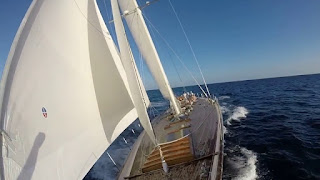Trickle down or trickle up technology?
Trickle down technology is a bit of a catch phrase often used these days for
examples of improved technology at high levels that finds its way into common
or everyday usage. Cars are a great example of this and how often do we take
for granted things like Velcro which was originally developed for weightless
space travel fastening.
Similarly with sail development, we have scenarios where leading-edge
technology has worked its way down into club racing and cruising scenarios.
Recently we have seen a big increase in short handed sailing
with a lot of clubs having a double handed division and watching some recent
footage of the start of the Melbourne-Osaka Yacht race, I saw a lot of
developments on these and other craft that have trickled up from the cruising division.
Short handed sailing is exactly that, fewer people sailing
the boat! Systems must be adapted to enable size and trim adjusting to take
place at a more refined and effortless way for ease of handling. Single line
mainsail reefing, powered winches or winch handles are often the norm.
The biggest factor that has trickled up from the cruising life is roller furling/reefing systems! These have come a long way from the original Wykeham-Martin bronze systems of my youth, advancements in engineering have seen some truly amazing developments. Sail shape and design has been developed to enhance performance on these systems to really improve the furled shape, things like foam or rope luff pads for better shape when furled are often a feature (but not always, ask your sailmaker, he usually has a wealth of experience to talk through what’s right for you!). It is not uncommon to see specifically designed boats with a row of Furlers in front of the mast offering all sorts of combinations and options. A semi furled sail is no where near as effective as a bespoke heavy weather jib but saves a lot of hassle deploying and reducing through the wind range as well as being a lot safer having not to go forrard in inclement conditions.
Downwind sails like asymmetric spinnakers, code O’s and screechers are a boon for the short-handed sailor who want a bit of turbo charging, once again there are some cool Furlers and snuffers to enable ease of handling. Yet again talk to your sailmaker, slower displacement like hulls may even be better with a conventional symmetric spinnaker set on a pole, which is still very manageable with a snuffer to take the anxiety out of using it.
Reefing headsail are also a possibility when using a hanked
option, either traditional bronze or soft hanks. While not suitable for fully
crewed sailing, a reef in a headsail and the accompanying convenience of not
having to do a full sail change with limited hands may be a suitable trade off.
As the sail will need to be over built to cope with the extra loading when
reefed in heavier winds (as well as the weight of the reef itself), this can
often add up to 30% extra weight and the reefed sail is usually not the ideal configuration
for optimum performance. But similarly to the semi furled headsail may be a the
lesser of two evils.
So short handed racing is still about speed, sometimes it’s
not the priority of a full crew race boats but efficiency in changing gears!
One of my coaching mantras is “the boat that is least slow is the fastest boat!’





Comments
Post a Comment